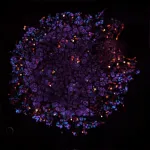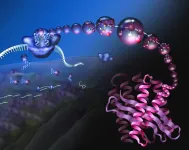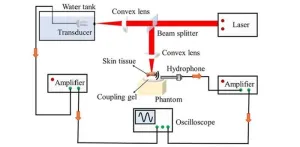(Press-News.org) We have a good understanding of how a woman’s external features can change during pregnancy, but scientists know surprisingly little about what biological changes occur internally.
A new Northwestern Medicine study, published June 5 in the journal Frontiers in Immunology, provides data about immune cells and biological changes (gene expression) in pregnant people at multiple timepoints before and during pregnancy. Using RNA sequencing and computational methods to estimate proportions of different activated types of immune cells in blood the team of scientists showed how pregnancy induces progressive changes in the maternal immune system each trimester, finding that neutrophil activation, one type of immune cell, changes dramatically.
“We estimated the proportions of different cell types in blood,” said lead and corresponding study author Damini Jawaheer, research associate professor of rheumatology at Northwestern University Feinberg School of Medicine. “One cell type, called neutrophils, just shot up during pregnancy. We see it went up during the first and second trimesters and then went down a tiny bit by the third trimester and postpartum. This suggests to us that neutrophils probably are doing something important during pregnancy.”
Few studies have looked at how immune cells behave during pregnancy and those that do do not include a pre-pregnancy baseline. This limited the information scientists could obtain from such studies because, in the absence of a pre-pregnancy reference, one cannot say exactly what changes happen during pregnancy. But a pre-pregnancy baseline involves identifying women who are going to be pregnant at some point in the future, which is difficult and therefore poses a barrier.
In the new study, the team identified healthy women who were planning to get pregnant and tracked them throughout their pregnancy. Only people with healthy pregnancies that were delivered at term were included in the results. The scientists looked at gene expression — rather than genes themselves — to gain a global understanding of biological changes. Not all genes are expressed at the same time: For example, when you eat, your insulin gene turns on for a time to process food.
The scientists then collected blood samples and used those to examine how much RNA each gene was producing, indicating how highly a gene was being expressed, before pregnancy and in each trimester. One striking finding was a distinct change in one cell type called neutrophils.
The function of neutrophils in pregnancy is poorly understood, said Jawaheer. Scientists know they are one of the first immune cells to respond when a cell is attacked by bacteria and viruses. Neutrophils also are the most abundant type of immune cell in blood. Jawaheer said her research conflicts with some past studies that implied neutrophils may have a negative impact on pregnancy, and instead points to a potentially protective effect.
“We think they may have a beneficial role because otherwise we would not see such a huge increase in those cell numbers among healthy women in term pregnancies,” Jawaheer said. “There needs to be more work done because we can’t say much about the function of the neutrophils from what we studied.
Jawaheer seeks to use these results to develop a deeper understanding of why rheumatoid arthritis (RA) improves naturally during pregnancy. She said the study takes her one step closer to answering the question that’s been her lab’s main focus: How does an incurable disease like RA just go away during pregnancy?
Before, without a “normal” reference point to draw from to understand what may be abnormal in RA pregnancy, Jawaheer had to create her own “normal reference.”
“This was just a first pass with very high-level findings,” Jawaheer said. “We have also collected other samples at different time points, and we’ll look at those next. Perhaps there’s some cell types other than neutrophils that play an important role in pregnancy that we weren’t able to see because we were looking at a mixture of all the cells in blood together.
“We also hope this normal reference can help people doing research on diseased pregnancies like preeclampsia because you need to know what ‘normal’ is to understand what’s abnormal in a diseased pregnancy. And a ‘normal’ that includes a pre-pregnancy baseline was totally missing until now.”
The study, “Pregnancy-associated systemic gene expression compared to a pre-pregnancy baseline, among healthy women with term pregnancies,” was supported by the National Institutes of Arthritis, Musculoskeletal and Skin Diseases (NIAMS), USA (grants R21AR057931 and R01AR073111) and Denmark (A1477-B512); and The Juliane Marie Center, Denmark.
END
Different genes are expressed at different stages during pregnancy, according to scientists
Findings provide a “normal reference”, describing biological changes that occur in the healthy mother’s blood during different trimesters of pregnancy
2023-06-13
ELSE PRESS RELEASES FROM THIS DATE:
USC Stem Cell’s journey towards 1,000 mini-kidneys begins with $1 million from KidneyX
2023-06-13
To help patients in need of transplants, artificial kidneys would have to function like their natural counterparts, but they wouldn’t necessarily have to look like them. With a new $1 million prize from the Kidney Innovation Accelerator, or KidneyX, a team of USC Stem Cell scientists led by Nils Lindström in collaboration with Leonardo Morsut are on a quest to build a kidney that resembles the real thing in function, but not in form.
“Nature has taught us that kidneys can come in an ...
Retooling the ribosomal translation machine could expand chemical repertoire of cells
2023-06-13
Synthetic biologists have become increasingly creative in engineering yeast or bacteria to churn out useful chemicals — from fuels to fabrics and drugs — beyond the normal repertoire of microbes.
But a multi-university group of chemists has a more ambitious goal: to retool the cell's polypeptide manufacturing plants — the ribosomes that spin amino acids into protein — to generate polymer chains that are more elaborate than what can now be made in a cell or a test tube.
The $20 million research enterprise centered at the University of California, Berkeley, is ...
Sickle cell disease is 11 times more deadly than previously recorded
2023-06-13
A new analysis provides a more complete picture of sickle cell disease mortality burden by combining disease prevalence data in different age groups and trends in overall survival when factoring in resulting secondary conditions.
When looking across all deaths, sickle cell disease is a leading cause of mortality in children under 5 years as well as in youth 5–14 years and adults 15–49 years.
Half a million babies were born with sickle cell disease in 2021, and 79% of these infants were in sub-Saharan Africa.
The largest increases ...
New approaches to evaluating water interventions around the globe
2023-06-13
Billions of people around the world face water insecurity. Although there are numerous projects from governments, NGOs, and private corporations who are committed to providing safely managed water and sanitation by 2030, a new study advocates for more holistic evaluation of water, sanitation, and hygiene (WASH) interventions.
According to the study by Justin Stoler, associate professor in the University of Miami College of Arts and Sciences Department of Geography and Sustainable Development, issues ...
ASCAP introduces slate of AI initiatives to help music creators navigate the future while protecting their work
2023-06-13
NEW YORK, June 13, 2023 – With the potential for artificial intelligence (AI) to create both massive disruption and great opportunity within the music industry, ASCAP — the only US PRO that operates on a not-for-profit basis — is introducing a slate of AI initiatives to help music creators navigate the future while protecting their work. These newly announced initiatives include: adoption by the ASCAP Board of Directors of a set of key ASCAP AI principles, creator education, startup incubation and policy development. Building upon ASCAP’s strong ...
Study in mice links heat-damaged DNA in food to possible genetic risks
2023-06-13
Researchers have newly discovered a surprising and potentially significant reason why eating foods frequently cooked at high temperatures, such as red meat and deep-fried fare, elevates cancer risk. The alleged culprit: DNA within the food that’s been damaged by the cooking process.
As shown for the first time known to the authors, this study by Stanford scientists and their collaborators at the National Institute of Standards and Technology (NIST), the University of Maryland, and Colorado State University reveals that components of heat-marred DNA can be absorbed during digestion and incorporated into the DNA of the consumer. That uptake directly ...
UC Irvine neuroscientists develop ‘meta-cell’ to move Alzheimer’s fight forward
2023-06-13
Irvine, Calif., June 13, 2023 – University of California, Irvine neuroscientists probing the gene changes behind Alzheimer’s disease have developed a process of making a “meta-cell” that overcomes the challenges of studying a single cell. Their technique has already revealed important new information and can be used to study other diseases throughout the body. Details about the meta-cell – created by researchers with the UCI Institute for Memory Impairments and Neurological Disorders, known as UCI MIND – were published in the online journal Cell Press.
Technologies called transcriptomics that study sets of RNA within organisms ...
What’s an underrated way to study decisions? Think out loud
2023-06-13
Think fast: if you’re running a race and overtake the person in second place, what position are you in? Many people instinctively respond that you’re in first place. However, upon reflection, some people realize the correct answer is that you’re now in second place: the former number-two runner slipped into third as you overtook them.
Trick questions of this kind are invaluable to cognitive scientists because they shed light on the cognitive quirks that shape our decision-making. “These aren’t just trick questions,” explained Nick Byrd, a philosopher-scientist and Intelligence Community Fellow who led the research at Stevens ...
Pass the salt: This space rock holds clues as to how Earth got its water
2023-06-13
Sodium chloride, better known as table salt, isn't exactly the type of mineral that captures the imagination of scientists. However, a smattering of tiny salt crystals discovered in a sample from an asteroid has researchers at the University of Arizona Lunar and Planetary Laboratory excited, because these crystals can only have formed in the presence of liquid water.
Even more intriguing, according to the research team, is the fact that the sample comes from an S-type asteroid, a category known to mostly lack hydrated, or water-bearing, minerals. The discovery strongly suggests ...
Understanding tumor microenvironment with photoacoustic spectral analysis
2023-06-13
Tumors are not just isolated clumps of abnormal cells but are associated with more complex system known as the “tumor microenvironment” (TME). Over the past few years, research has revealed that the TME consists of a complex combination of blood vessels, connective tissue, and a matrix of extracellular proteins and molecules. Most importantly, the composition of the TME is different from that of nearby healthy tissues. In particular, the lipid and collagen contents of tumors differ from those of normal tissues, making them important potential biomarkers for diagnosing various types of ...
LAST 30 PRESS RELEASES:
UT Health San Antonio awarded $3 million in CPRIT grants to bolster cancer research and prevention efforts in South Texas
Third symposium spotlights global challenge of new contaminants in China’s fight against pollution
From straw to soil harmony: International team reveals how biochar supercharges carbon-smart farming
Myeloma: How AI is redrawing the map of cancer care
Manhattan E. Charurat, Ph.D., MHS invested as the Homer and Martha Gudelsky Distinguished Professor in Medicine at the University of Maryland School of Medicine
Insilico Medicine’s Pharma.AI Q4 Winter Launch Recap: Revolutionizing drug discovery with cutting-edge AI innovations, accelerating the path to pharmaceutical superintelligence
Nanoplastics have diet-dependent impacts on digestive system health
Brain neuron death occurs throughout life and increases with age, a natural human protein drug may halt neuron death in Alzheimer’s disease
SPIE and CLP announce the recipients of the 2025 Advanced Photonics Young Innovator Award
Lessons from the Caldor Fire’s Christmas Valley ‘Miracle’
Ant societies rose by trading individual protection for collective power
Research reveals how ancient viral DNA shapes early embryonic development
A molecular gatekeeper that controls protein synthesis
New ‘cloaking device’ concept to shield sensitive tech from magnetic fields
Researchers show impact of mountain building and climate change on alpine biodiversity
Study models the transition from Neanderthals to modern humans in Europe
University of Phoenix College of Doctoral Studies releases white paper on AI-driven skilling to reduce burnout and restore worker autonomy
AIs fail at the game of visual “telephone”
The levers for a sustainable food system
Potential changes in US homelessness by ending federal support for housing first programs
Vulnerability of large language models to prompt injection when providing medical advice
Researchers develop new system for high-energy-density, long-life, multi-electron transfer bromine-based flow batteries
Ending federal support for housing first programs could increase U.S. homelessness by 5% in one year, new JAMA study finds
New research uncovers molecular ‘safety switch’ shielding cancers from immune attack
Bacteria resisting viral infection can still sink carbon to ocean floor
Younger biological age may increase depression risk in older women during COVID-19
Bharat Innovates 2026 National Basecamp Showcases India’s Most Promising Deep-Tech Ventures
Here’s what determines whether your income level rises or falls
SCIE indexation achievement: Celebrate with Space: Science & Technology
Children’s Hospital Colorado performs region’s first pediatric heart and liver dual organ transplant
[Press-News.org] Different genes are expressed at different stages during pregnancy, according to scientistsFindings provide a “normal reference”, describing biological changes that occur in the healthy mother’s blood during different trimesters of pregnancy




